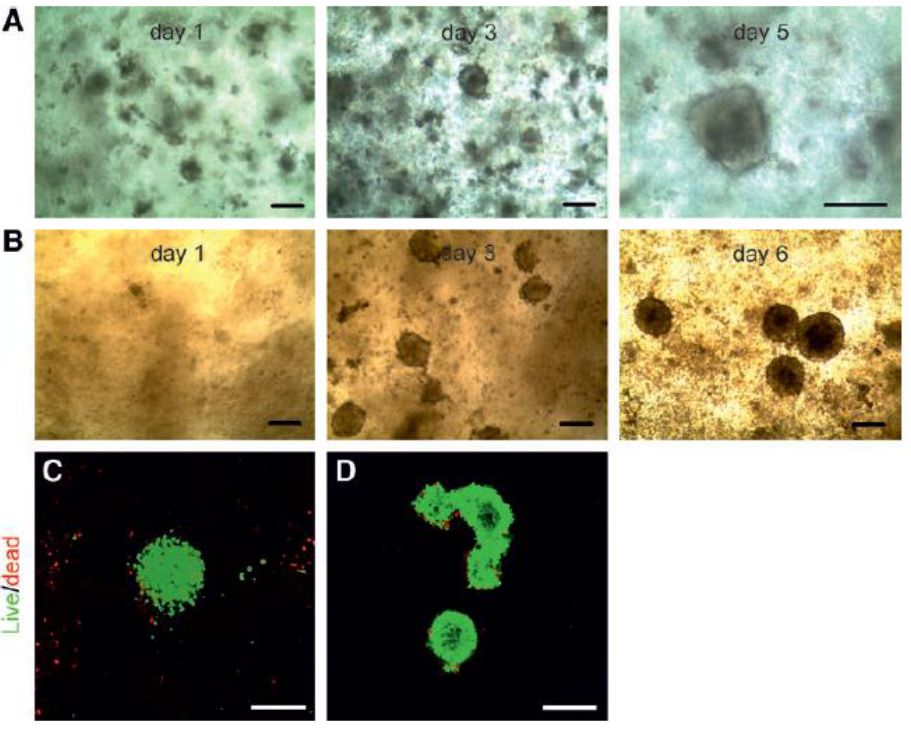Yan-Ru Lou (Ph.D.), University of Helsinki, Finland
Introduction
In recent years there has been a drive to move away from the traditional 2D cell culture systems to what is considered the more physiologically relevant three dimensional (3D) models. It is thought cells cultured in 3D more closely mimic the in vivo cell niche that supports cell proliferation. Here we present a 3D model that has been developed for the culture of human embryonic stem cells (hESC) and induced pluripotent stem cells (iPCS) where WA07 and H9-GFP (modified from H9)hESC lines and iPCS (IMR90)-4 cells were used for the study. Cells were cultured in GrowDex®for 9 days in a 96-well plate format, where cell proliferation rates and spheroid formation was observed and reported. Spheroids provide an useful 3D model for studying disease states such as cancer and offer a simple to use platform for drug discovery and regenerative medicine research. Developing the assay in a 96-well plate format allows easy transfer to automated systems for scale up and higher throughput as required for high throughput screening (HTS).
Materials
- H9-GFP modified from H9 (WA09, WiCell) WA07 and iPS(IMR90)-4 (WiCell)
- mTeSR1 medium (STEMCELL Technologies)
- GrowDex 1.5 % (UPM)
- 1mg/ml dispasesolution (STEMCELL Technologies)
- Live/dead viability/cytotoxicity kit (Invitrogen)
Method
- GrowDex hydrogel stock was diluted with culture medium to a concentration of 0.5 %.
- Cells previously seeded and cultured in 2D were detached from the culture vessel by non-enzymatic cell dissociation reagent and collected by centrifugation at 200g for 5 min.
- The supernatant was removed and the pellet re-suspended carefully in culture medium. The hESCswere seeded as small colonies, not as single cells or small groups of cells. The small colonies were generated by passing them through 1000 μl pipette tip approximately 10 times.
- Cell seeding density used for 3D culture in GrowDex was five times higher than that of the 2D culture before passage. The appropriate number of colonies were mixed with GrowDexby careful pipette transfer and slow mixing with the pipette tip in the solution to ensure an even distribution of the colonies in the gel.
- 100 μl of cell/GrowDex mix was transferred to each well of the 96-well plate and 100 μl of culture medium added on top of cell/GrowDex mix carefully to ensure the gel was not disturbed.
- Cells were maintained for 9 days at 37°C with 5% CO2 in a humid atmosphere. Culture medium was renewed daily.
- Cell viability was assessed using the Live/Dead viability/cytotoxicity kit according to manufacturer’s instructions and spheroid formation observed by standard microscopy.
Results
Here, we propose a new concept of hPSC culture, which is a flexible, xeno-free 3D in vitro culture system. We have demonstrated cells can be successfully cultured, cell viability retained and spheroids formed ranging in size from 100-200 nm. Unlike most polysaccharide-based hydrogels that require a separate cross-linking step, GrowDex can be used following simple dilution with media. Additionally, hydrogels generated by cross-linking have fixed physical properties, whereas the physical property of GrowDex is dependent on its concentration determined by dilution, not on the degree of crosslinking. Phase-contrast images show that cell density and spheroid diameter increased with culture time. The cells in 3D spheroids remained alive during the culture as shown in live/dead viability assays at the end of sub-cultures.

Figure 1. Human embryonic stem cells (hESCs) and induced pluripotent stem cells (iPSCs) form three-dimensional (3D) spheroids in GrowDex. A time course shows that WA07 (A) and iPS(IMR90)-4 (B) cells formed3D spheroids in 0.5.% GrowDex. Live/dead staining images show living WA07 (C) and iPS(IMR90)-4 (D) cells in the spheroids on day 9. Scale bars = 200 mm. Reproduced with permission from (1). Copyright 2014, Mary Ann Liebert, Inc.
Conclusion
This study shows that GrowDex can offer a flexible, xeno-free 3D model for culture of hESC and iPS cells and opens up a new avenue for better recapitulation of the natural ESC environment and embryonic development. This previously has not been possible with conventional 2D cultures methods.
(1) Lou Y-R et al. 2014 “The Use of Nanofibrillar Cellulose Hydrogel As a Flexible Three-Dimensional Model to Culture Human Pluripotent Stem Cells. STEM CELLS AND DEVELOPMENT 23:4, pp. 380-392.